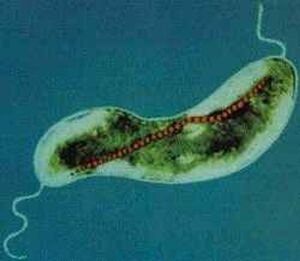Magnetospirillum magnetotacicum
Classification
Bacteria (Domain); Proteobacteria (Phylum); Alphaproteobacteria (Class); Rhodospirillale (Order); Magnetospirillum (Family)
Species
|
NCBI: [1] |
Magnetospirillum magnetotacticum
Description and Significance
Describe the appearance, habitat, etc. of the organism, and why you think it is important.
Magnetospirillum magnetotacticum was found in microaerobic zones in freshwater (Wessel). This organism has magnetic crystals in it that form in a straight line along with flagella that both serve to help the organism thrive in its environment (Parlade, 2018).
This organism creates magnetosomes that assist in the growth of the Magnetospirillum magnetotacticum. The magnetosomes are magnetic crystals that use the Earth's magnetic field to orient themselves to where they will grow best (Wessel). The magnetification allows for the bacteria to remain in a specific habitat for optimal growth, this is zones where there is low oxygen (Parlade, 2018).
Genome Structure
Describe the size and content of the genome. How many chromosomes? Circular or linear? Other interesting features? What is known about its sequence?
The genome sequence of M. magnetotacicum is found in the strain MS-1 that has 36 contigs and 4,136 protein-coding genes. In it's final sequencing the strain was found to be 4,523,935 bp.
Cell Structure, Metabolism and Life Cycle
Interesting features of cell structure; how it gains energy; what important molecules it produces.
The organism Magnetospirillum magnetotacicum is a rod-shaped bacterium (lins, 2009). These organisms are chemoorganoheterotrophs that use organic acids as a source of electrons and carbon (Lins,2009). It has chain-like magnetosomes that are intercellular as well as flagella to be motile. It produces magnetosomes which are dependent on iron and oxygen levels and are structures made within M. magnetotacium (Alphandery). These magnetosomes are important in the survival of the organism as they allow for the organism to be in an optimal growth location. This is because magnetosomes use the Earth's magnetic field to navigate (Wang, 2017).
In low oxygen environments this organism thrives. Magnetsosomes are the functional unit of M. Magnetotacicum based on the need for survival in the Earth's magnetic field.
Ecology and Pathogenesis
Habitat; symbiosis; biogeochemical significance; contributions to environment.
If relevant, how does this organism cause disease? Human, animal, plant hosts? Virulence factors, as well as patient symptoms.
M. magnetotacium are found in freshwater and chemically stratified water columns (Lefevre,2013). This is in habitats of oxic-anoxic interface. (Lefevre,2013). These organisms are gradient favoring organisms. There is a hypothesis that there is a symbiotic magnetic sensing theory that has to do with animals. Magnetic sensing animals comes from the idea of magnetoreception being prevalent in the animal kingdom (Nantan,2020). Possible mechanisms of this include: physical aggregations, aggregations facilitating a neural response, and cell-cell communication (Nantan, 2020). There are still many questions on this hypothesis but it is belived that animals do have a sense for mangetosomes.
References
Lefevre, C., Bazylinski, D. Ecology, Diversity, and Evolution of Magnetotactic Bacteria (2013(. https://doi.org/10.1098/rstb.2019.0595
Nantan,E., Fitak, R., Werber, Y., Vortman, Y., Symbiotic magnetic sensing: raising evidence and beyond, (2020) https://doi.org/10.1098/rstb.2019.0595
Smalley MD, Marinov GK, Bertani LE, DeSalvo G. 2015. Genome sequence of Magnetospirillum magnetotacticum strain MS-1. Genome Announc 3(2):e00233-15. doi:10.1128/genomeA.00233-15
Wang, Q., Wang, X., Zhang, W. et al. Physiological characteristics of Magnetospirillum gryphiswaldense MSR-1 that control cell growth under high-iron and low-oxygen conditions. Sci Rep 7, 2800 (2017). https://doi.org/10.1038/s41598-017-03012-4
Author
Page authored by Helen Grace Petty, student of Prof. Bradley Tolar at UNC Wilmington.

